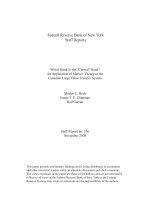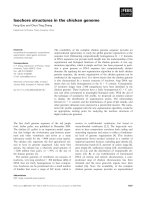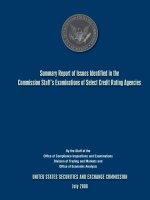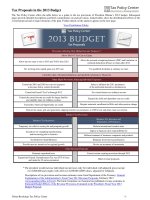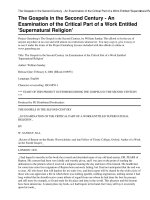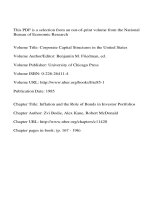Madalina cotrut international tax structures in the BEPS era an analysis of anti abuse measures
Bạn đang xem bản rút gọn của tài liệu. Xem và tải ngay bản đầy đủ của tài liệu tại đây (2.54 MB, 262 trang )
International Tax Structures in the BEPS Era:
An Analysis of Anti-Abuse Measures
Editorial Team
Madalina Cotrut
(Managing Editor)
Aleksandra Bal
Rijkele Betten
Ridha Hamzaoui
Belema Obuoforibo
Ola Ostaszewska
Volume 2
IBFD Tax Research Series
Visitors’ address:
Rietlandpark 301
1019 DW Amsterdam
The Netherlands
Postal address:
P.O. Box 20237
1000 HE Amsterdam
The Netherlands
Telephone: 31-20-554 0100
Fax: 31-20-622 8658
www.ibfd.org
© 2015 IBFD
All rights reserved. No part of this publication may be reproduced, stored in a retrieval system or
transmitted in any form or by any means, electronic, mechanical, photocopying, recording or
otherwise, without the written prior permission of the publisher. Applications for permission to
reproduce all or part of this publication should be directed to:
Disclaimer
This publication has been carefully compiled by IBFD and/or its author, but no representation is
made or warranty given (either express or implied) as to the completeness or accuracy of the
information it contains. IBFD and/or the author are not liable for the information in this
publication or any decision or consequence based on the use of it. IBFD and/or the author will not
be liable for any direct or consequential damages arising from the use of the information
contained in this publication. However, IBFD will be liable for damages that are the result of an
intentional act (opzet) or gross negligence (grove schuld) on IBFD’s part. In no event shall IBFD’s
total liability exceed the price of the ordered product. The information contained in this
publication is not intended to be an advice on any particular matter. No subscriber or other reader
should act on the basis of any matter contained in this publication without considering appropriate
professional advice.
Where photocopying of parts of this publication is permitted under article 16B of the 1912
Copyright Act jo. the Decree of 20 June 1974, Stb. 351, as amended by the Decree of 23
August 1985, Stb. 471, and article 17 of the 1912 Copyright Act, legally due fees must be paid
to Stichting Reprorecht (P.O. Box 882, 1180 AW Amstelveen). Where the use of parts of this
publication for the purpose of anthologies, readers and other compilations (article 16 of the
1912 Copyright Act) is concerned, one should address the publisher.
ISBN 978-90-8722-333-5 (print)
ISBN 978-90-8722-334-2 (eBook)
ISSN 2452-2104
Foreword
The tax world is in a state of flux – certainly the BEPS project has seen to that. The former
certainties are no longer sure, and questions abound everywhere.
It is against this backdrop that this book was conceived. Its aim is a simple one – to clarify the
finer and wider points of the BEPS story, casting this narrative against a thorough analysis of
relevant anti-avoidance rules.
This book does two things. First, in picking up the key themes of the BEPS project, it provides a
solid critique of the main proposals set out by the OECD. Each chapter draws its authority from
in-depth research carried out by its author, not only into the OECD proposals, but also into
existing domestic and international tax measures. This approach provides the reader with a clear
view on how the BEPS proposals would, or could, work in practice. Second, this book is
invaluable for the excellent analysis that it provides on the main anti-avoidance rules currently in
force, whether set out in domestic law, or under tax treaties. How these would interact with the
BEPS proposals, and where the challenges remain – those are the key themes of this timely
publication.
This book is written entirely by a team of researchers at IBFD. Drawing upon their own specialist
expertise, each author has brought to this book a contribution of ideas, research, and rich
experience. Such research activities enrich us in our daily work. It is our expectation that our
readers are similarly enriched.
Belema R. Obuoforibo CTA ATT (Fellow)
Director, IBFD Knowledge Centre
General Acknowledgements
The editorial team would like to thank the authors for their tremendous efforts in drafting the
chapters of this book.
Special thanks go to the research staff of the IBFD Knowledge Centre for the provision of
valuable input in the initial research phase, to the IBFD Library and Information Centre for their
constant support of the research, to the IBFD Production Coordination Department for their work
and efforts to ensure the timely release of this book.
Introduction
Tax planning structures used by some MNEs (where it is considered that low or no tax is paid in
comparison with small-sized enterprises and individuals), have become the bane of policymakers
nowadays, at OECD level as well as at EU level. This is due to the fact that recent statistics
revealed that the public budgets were deprived of billions of euros.
The OECD and G20 members initiated the BEPS Action Plan based on the idea that “BEPS is a
global problem which requires global solutions”. 1 The objectives of the BEPS Action Plan are to
release reports which “will give countries the tools they need to ensure that profits are taxed
where economic activities generating the profits are performed and where value is created, while
at the same time give business greater certainty by reducing disputes over the application of
international tax rules, and standardising requirements”. 2
At EU level, the European Commission is working on a Tax Transparency Package where the key
element is “to introduce the automatic exchange of information between EU Member States on
their tax rulings”. 3 The next step is to launch an Action Plan on Corporate Taxation to “focus on
measures to make corporate taxation fairer and more efficient within the Single Market, including
a re-launch of the Common Consolidated Corporate Tax Base (CCCTB) and ideas for integrating
the work of OECD and G20 members to combat BEPS at EU level”. 4
Within the context of these developments, this book examines the anti-abuse measures that
already exist in different countries and scrutinizes how effective these measures are in countering
abusive tax structures. This book can be considered complementary to the reports issued, or to be
issued, by the OECD as it provides practical information on what happens in various countries that
encounter abusive tax structures and evaluates the effectiveness of anti-abuse measures. It also
discusses the measures proposed by the OECD until 1 May 2015, with some exceptions.
Part One provides the reader with a global overview of the most common strategies against tax
avoidance by trying to find clear answers to what tax avoidance is and what the conditions are that
facilitate and encourage tax avoidance (see chapter 1). The authors agree that, although taxpayers
are free to organize their affairs as they consider fit within the law, they should nevertheless pay
their “fair share of tax”. Unfortunately, the principle of “fair share of tax” is not defined and
policymakers and taxpayers frequently meet challenges, not least due to uncertainty.
Part Two focuses on key concepts in international tax structuring, such as the use of PEs (see
chapter 2) and the exploitation of transfer pricing rules (see chapter 3) in the current tax arena.
Much attention is paid to the problems arising from the narrow scope of the definition of the
permanent establishment. However, the authors emphasize that no concrete proposals have yet
been put forward as regards the profit allocation to such a PE and recommend that it would be
better to consider some form of quantitative profit threshold for deeming the presence of a PE.
Furthermore, the arm’s length principle is vital in the quest for more transparency, as intra-group
transactions will be increasingly scrutinized by the tax authorities. However, at this stage, there is
no clear guidance on how taxpayers and tax authorities will benefit from the new reporting rules.
The third part of the book focuses on tax structuring used for financing activities. The authors
analyse the state of practice and recent developments in various countries related to intra-group
debt financing (see chapter 4), as well as transactions involving hybrid instruments (see chapter 5)
and hybrid entity mismatches (see chapter 6).
The final four chapters analyse the most common tax structures related to selected business
models, specifically related to supply chain management (see chapter 7), IP migration and
exploitation (see chapter 8), the digital economy (see chapter 9), and holding companies (see
chapter 10).
This book highlights the intricacies of the anti-abuse measures that the countries apply in
countering abusive tax structures, which are expected to be relevant for EU and OECD work.
Similarly, the book highlights the challenges implicit in the recommended measures in the draft
reports issued by the OECD until 1 May 2015, with some exceptions.
We hope this book will stimulate further discussion and be of use to practitioners, students and
policymakers.
Madalina Cotrut
Managing Editor
1 May 2015
1. About BEPS, available at: />2. Id.
3. European Commission – Press Release, Brussels 18 March 2015, available at:
/>4. Id.
Abbreviations and Acronyms
BEPS
BEPS Action Plan
CFC
ECJ
EC
EEA
EU
GAAR
G20
IP
MNE
PE
OECD
OECD Model
SAAR
TFEU
UN Model
VAT
Base erosion and profit shifting
OECD and G20 Action Plan on Base Erosion and Profit Shifting
Controlled foreign company
Court of Justice of the European Union
European Community
European Economic Area
European Union
General anti-avoidance rule /general anti-abuse rule
Argentina, Australia, Brazil, Canada, China, France, Germany,
India, Indonesia, Italy, Japan, Mexico, Russia, Saudi Arabia, South
Africa, South Korea, Turkey, the United Kingdom and the United
States and the EU
Intellectual property
Multinational enterprise
Permanent establishment
Organisation for Economic Co-operation and Development
OECD Model Tax Convention on Income and on Capital
Specific anti-avoidance rule/specific anti-abuse rule
Treaty on the Functioning of the European Union (formerly EC
Treaty)
United Nations Model Convention on Income and Capital
Value added tax
Table of Contents
Foreword
General Acknowledgements
Introduction
Abbreviations and Acronyms
Part One
Recent Developments in International Tax Structuring
Chapter 1:
1.1.
1.2.
1.2.1.
1.2.1.1.
1.2.1.2.
1.2.1.3.
1.2.2.
1.3.
1.3.1.
1.3.1.1.
1.3.1.1.1.
1.3.1.1.2.
1.3.1.1.3.
1.3.1.1.4.
1.3.1.2.
1.3.1.2.1.
1.3.1.2.2.
1.3.1.3.
1.3.1.3.1.
1.3.1.3.2.
1.3.2.
1.3.2.1.
1.3.2.2.
1.3.2.3.
Common Strategies against Tax Avoidance: A Global Overview
Lydia G. Ogazón Juárez and Ridha Hamzaoui
Introduction
Tax avoidance: General
Scope of the term
Tax avoidance versus tax evasion
Tax avoidance versus tax planning
The role of policymakers in defining clear boundaries
Conditions facilitating tax avoidance
Tax planning schemes: Domestic law and treaty provisions
Domestic law rules
Regimes allowing for exemption of foreign-source income
Patent box regimes
Participation exemption regimes
Holding company regimes
Territorial tax systems
Regimes allowing the use of mismatches between tax rules in
different countries
US check-the-box regime
Use of hybrid financial instruments and entities
Provisions relating to residence
Dual resident companies and stateless companies
Tie-breaker rule for companies
Tax treaty rules
Tax sparing clauses
Modification of treaty classification of income
Circumvention of thresholds found in treaty provisions
1.4.
1.4.1.
1.4.1.1.
1.4.1.2.
1.4.1.3.
1.4.1.4.
1.4.2.
1.4.2.1.
1.4.2.2.
1.4.2.2.1.
1.4.2.2.2.
1.4.3.
1.4.4.
1.4.4.1.
1.4.4.2.
1.4.4.3.
1.4.4.4.
1.5.
Annexes
Countering aggressive tax planning
Domestic legislation: General anti-avoidance rules
General anti-avoidance rules generally
The concept of “arrangement” or “scheme”
The concept of “tax benefit” or “tax advantage”
Compatibility of domestic GAARs with tax treaties
Domestic legislation: Specific anti-abuse rules
Specific anti-abuse rules in particular
Controlled foreign company rules
CFC rules: Main features
Strengthening CFC rules: BEPS Action 3
Tax treaties: Anti-abuse provisions
Another approach: Exchange of information and cooperation
between tax authorities
Convention on Mutual Administrative Assistance in Tax Matters
Standard for Automatic Exchange of Financial Account
Information
OECD Aggressive Tax Planning Directory
United States: Foreign Account Tax Compliance Act
Conclusion
Part Two
New Roles of the Concepts in International Tax Structuring
Chapter 2:
2.1.
2.2.
2.2.1.
2.2.1.1.
2.2.1.2.
2.2.1.3.
2.2.2.
2.2.3.
2.2.3.1.
2.2.3.2.
2.3.
2.4.
2.4.1.
Permanent Establishments in International Tax Structuring
Rijkele Betten and Monia Naoum
Introduction
Use of permanent establishments for tax structuring purposes
Avoidance of permanent establishment status
Commissionaire arrangements
Splitting up of contracts
Undertaking activities of a preparatory or auxiliary nature
Limited attribution of profits to permanent establishments
Intentional creation of a permanent establishment
Exemption regimes
Financing structures
Approach of countries to tackling abuse structures
BEPS Action Plan
Artificial avoidance of permanent establishment status through
commissionaire agreements and similar strategies
2.4.2.
Artificial avoidance of permanent establishment status through the
specific activity exemptions
2.4.3.
2.4.4.
Splitting up of contracts
Profit attribution to permanent establishments and interaction with
Actions on transfer pricing
Limitation and restrictions regarding solutions
Conclusions and expectations
2.5.
2.6.
Chapter 3:
3.1.
3.2.
3.2.1.
3.2.2.
3.2.3.
3.2.3.1.
3.2.3.2.
3.2.3.3.
3.3.
3.3.1.
3.3.2.
3.3.3.
3.3.4.
3.4.
Transfer Pricing from the Perspective of Substance and
Transparency: Is the OECD on the Right Track?
Anuschka J. Bakker
Introduction
Selected transactions with transfer pricing relevance
Business restructurings
Services
Intra-group financing
Background
Intercompany loans
Guarantees
Transfer Pricing and the BEPS Action Plan
Country-by country reporting
Low-value-adding services
Changes to Chapter I of the OECD Guidelines
Financial transactions
Conclusion
Part Three
Financing Activities
Chapter 4:
4.1.
4.2.
4.2.1.
4.2.1.1.
4.2.1.2.
4.2.1.3.
4.2.1.4.
4.2.1.5.
Anti-Base-Erosion Measures for Intra-Group Debt Financing
René Offermanns and Boyke Baldewsing
Introduction: Funding with debt or equity?
Tax structures for group financing and the applicable anti-base
erosion measures
Tax structures using a low-taxed group financing company
Thin capitalization rules as an anti-base erosion measure
General anti-abuse rules
Restrictions in the case of notional interest deduction regimes
CFC rules
Restrictions applicable to payments to tax haven entities
4.2.2.
4.2.2.1.
Tax structures using a finance company with a financing branch
Anti-triangular rule in tax treaties to counter the use of low taxed
finance branches
4.2.2.2.
4.2.3.
4.2.3.1.
Substance at the level of the financing branch
Tax structures using back-to-back loans
Substance and residence requirement for holding companies to
obtain tax treaty protection
Beneficial ownership requirement
Limitation on benefits provision
Anti-abuse rules in tax treaties
Recent developments of the BEPS Action Plan
Context of Action 4
Summary of the three main recommendations under Action 4
Conclusion
4.2.3.2.
4.2.3.3.
4.2.3.4.
4.3.
4.3.1.
4.3.2.
4.4.
Chapter 5:
5.1.
5.2.
5.2.1.
5.2.2.
5.2.3.
5.2.4.
5.3.
5.3.1.
5.3.1.1.
5.3.1.2.
5.3.1.3.
5.3.2.
5.3.2.1.
5.3.2.2.
5.3.2.3.
5.3.2.4.
5.3.2.5.
5.3.2.6.
5.4.
Chapter 6:
Hybrid Instruments in the Post-BEPS Era
Shee Boon Law and Marjolein Kinds
Introduction
OECD recommendations on hybrid instrument mismatches
Direct hybrid mismatches
Hybrid transfers
Indirect hybrid mismatches
Hybrid mismatches and other actions in the BEPS Action Plan
Managing coordination rules under domestic law
Relationship between the OECD recommendations and other
domestic law
Netherlands
New Zealand
United States
Other technical considerations
Timing mismatches
Structured arrangements
Policy exceptions
Deduction/non-inclusion outcomes caused by character and
ownership mismatches
Bona fide hybrids
Tax treaty considerations
Conclusion
Past, Present and Future of Tax Structuring Using Hybrid Entity
Mismatches
Oana Popa
6.1.
6.2.
6.2.1.
6.2.2.
6.2.3.
6.3.
6.3.1.
6.3.2.
6.3.2.1.
6.3.2.2.
6.3.2.2.1.
6.3.2.2.2.
6.3.2.3.
6.3.2.3.1.
6.3.2.3.2.
6.3.2.3.3.
6.3.3.
6.4.
6.4.1.
6.4.1.1.
6.4.1.2.
6.4.1.3.
6.4.2.
6.4.3.
6.5.
Introduction: Hybrid entity mismatches in the spotlight
Tax structures using hybrids and reverse hybrids: Manipulating
mismatches
(Ab)using the domestic rules for entity classification
Basic models of tax structuring using hybrid entity mismatches
Practical aspects
Rules addressing hybrid entity mismatches before BEPS
Experiences of various countries before BEPS
Countries’ options before BEPS
GAARs: An answer to artificial features of hybrid entity
mismatches
SAARs: Same purpose from two perspectives – Source and
residence state defence against hybrid entity mismatches
CFC rules
Rules limiting interest deduction
Other rules
Withholding taxes
Anti-tax haven rules
Reconsideration of group consolidation regimes
Lessons for the future
Rules addressing hybrid entity mismatches in the BEPS era
OECD recommendations
Arrangements that produce DD outcomes
Arrangements that produce D/NI outcomes
Arrangements using reverse hybrids
Responses of countries to BEPS: Current state of affairs
Hybrid entity mismatches in the BEPS era: Closely scrutinized
worldwide
Concluding remarks
Part Four
Selected Business Models
Chapter 7:
7.1.
7.2.
Business Restructurings: The Toolkit for Tackling Abusive
International Tax Structures
Madalina Cotrut and Laura Ambagtsheer-Pakarinen
Overview of potential reasons for business restructuring
Typical business restructuring models
7.2.1.
7.2.2.
7.2.3.
7.2.4.
7.3.
7.3.1.
7.3.2.
7.3.3.
7.3.4.
7.3.5.
7.3.6.
7.3.7.
7.4.
Chapter 8:
8.1.
8.2.
8.3.
8.3.1.
8.3.2.
8.3.3.
8.3.3.1.
8.3.3.2.
8.4.
8.4.1.
8.4.2.
8.5.
Chapter 9:
9.1.
9.2.
9.3.
9.3.1.
9.3.2.
9.3.3.
Restructuring manufacturing activities
Restructuring distribution activities
Centralization of services
IP and centralization
Business restructuring structures and anti-abuse measures: The
fight for substance
Testing business restructurings by applying GAARs
Testing substance by analysing available documentation
Transfer pricing analysis
Analysis of the substance of the principal
Testing the PE exposure
Testing whether compensation upon conversion should be paid
Restricting the tax deductibility of expenses arising from a
conversion
Conclusions
Intellectual Property Structuring in the Context of the OECD
BEPS Action Plan
Ruxandra Vlasceanu
Setting the scene
Structuring IP
Impact of the BEPS Action Plan
General comments
Actions tackling the prevention of double non-taxation
Action 5 on harmful tax practices
Existing regimes
Specific comments on Action 5
Recent developments and a blueprint for the future
Domestic provisions targeting aggressive tax planning
The redesign of IP regimes
Concluding remarks
Taxation of the Digital Economy
Aleksandra Bal and Carlos Gutiérrez
Introduction: The digital economy as a new way of doing business
Concept of the digital economy
Tax challenges of the digital economy
Residence taxation
Source taxation: Physical versus digital presence
Source taxation: Taxation of business profits of a PE
9.3.4.
9.3.5.
9.3.5.1.
9.3.5.2.
Income characterization
Indirect taxation: EU VAT
Digital supplies
Distance sales
9.3.5.3.
9.4.
9.4.1.
9.4.2.
9.4.3.
9.5.
Intermediaries
National initiatives concerning the digital economy
New PE concepts
New taxes on specific transactions
New taxes on profits
Conclusion
Chapter 10:
International Tax Structuring for Holding Activities
Andreas Perdelwitz
10.1.
10.2.
10.2.1.
10.2.2.
10.3.
10.3.1.
10.3.2.
10.3.3.
10.4.
10.4.1.
10.4.2.
10.4.3.
10.4.4.
10.4.5.
10.5.
10.5.1.
10.5.2.
10.5.2.1.
10.5.2.2.
10.5.2.3.
10.5.2.4.
10.5.3.
10.6.
List of Authors
Introduction
General characteristics of holding companies
Legal forms
Types
Planning strategies and key criteria for holding locations
Repatriation strategies
Allocation strategies
Key criteria for holding company locations
Limits on tax structuring with holding companies
General anti-abuse rules
Transfer pricing
Residence
Beneficial ownership requirement
Interim conclusion
Potential impact of the BEPS Action Plan
Action 6: Prevent treaty abuse
Limitation on benefits rules in tax treaties
Publicly-traded companies test
Ownership/base erosion test
Active business test
Derivative benefits test
Principal-purpose test under tax treaties
Conclusion
Part One
Recent Developments in International Tax Structuring
Chapter 1
Common Strategies against Tax Avoidance: A Global Overview
Lydia G. Ogazón Juárez and Ridha Hamzaoui *
1.1. Introduction
As a starting point for a chapter on tax avoidance strategies, it is pertinent to address several
questions. First, precisely what is meant by the term “tax avoidance”? Second, what are the
conditions that facilitate and encourage tax avoidance? A clear answer to the first question would
define the scope of this chapter. A clear answer to the second would make apparent the necessity
for properly drafted rules, as well as provide useful analysis of the likely success (or otherwise) of
particular anti-avoidance rules.
This chapter is structured as follows:
Section 2 addresses the precise scope of the term “tax avoidance”, recognizing the clear
distinction between “avoidance” and “evasion”, as well as the unclear distinction between the
former and “tax planning”. The authors make the argument for certainty, and highlight the role of
policymakers in clarifying the scope of these terms. The main conditions that facilitate and
encourage tax avoidance are also examined.
Section 3 offers a brief overview of the main tax planning considerations taken into account by
taxpayers. This is necessary as a precursor to the discussion that follows in section 4.
Section 4 is the heart of the chapter: now that there is some clarity on the scope of tax planning
and tax avoidance (section 2), and the schemes that taxpayers frequently employ in pursuit of
those objectives, have become clear (section 3), the question arises as to what governments around
the world have been doing to address this, and how successful (or otherwise) have their efforts
been.
Section 5 presents the authors’ conclusions.
The chapter is set against the backdrop of the OECD’s efforts against BEPS. 1 The BEPS project
sprang into life in February 2013, with a report outlining the key issues and setting out proposals
for an Action Plan. In July 2014, the OECD issued the Action Plan, which contained 15 specific
actions to address BEPS (see Table 1) in a comprehensive and coordinated manner. The objective
of those actions was:
to complement existing standards that are designed to prevent double taxation with
instruments that prevent double non-taxation in areas previously not covered by international
standards and that address cases of no or low taxation associated with practices that
artificially segregate taxable income from the activities that generate it. 2
Each action describes the issues to be addressed, the expected outcome and the deadline. The
Action Plan is expected to be completed within a two-year period, taking into account that some
actions have already been advanced while others might require longer-term work.
The Action Plans will be analysed in detail elsewhere in this publication. 3
The European Union has also made concerted efforts in the fight against tax fraud and tax evasion.
In December 2012, the European Union presented an Action Plan 4 in this regard. The Action Plan
sets out a comprehensive set of 34 measures “to help member states to protect their tax bases and
recover billions of euros legitimately due”. 5 Most of those actions are also included in the BEPS
Action Plan. 6 The 34 actions of the EU Action Plan are summarized in Table 2.
1.2. Tax avoidance: General
1.2.1. Scope of the term
1.2.1.1. Tax avoidance versus tax evasion
Tax avoidance is a term:
generally used to describe the arrangement of a taxpayer’s affairs that is intended to reduce
his tax liability. Although the arrangement could be legal (i.e. in line with “the letter of the
law”), it is usually in contradiction with the intent of the law it purports to follow (i.e. against
“the spirit of the law”). 7
Therefore, tax avoidance is, in principle, lawful because the tax advantage is being sought within
the boundaries of the rules. This behaviour has pushed the legislatures in several countries to
enact measures dedicated to counter tax avoidance schemes, whether they are meant to catch all
types of tax schemes or are designed to restrict only a specific type of avoidance.
Tax avoidance is contrasted with tax evasion where a taxpayer takes steps to avoid paying a tax
liability that has already arisen. 8 Tax evasion carries an element of dishonesty. In this sense, the
term “tax evasion” is “generally used to mean illegal arrangements where the liability to tax is
hidden or ignored”. 9
In addition, tax evasion may be characterized as intentional illegal behaviour consisting of not
declaring, or under-declaring, income or assets which are subject to tax, which is often sanctioned
by financial or criminal penalties. 10
1.2.1.2. Tax avoidance versus tax planning
The distinction between tax avoidance and tax planning seems more difficult to determine. Both,
tax avoidance and tax planning involve tax reduction arrangements that may comply with the
specific wording of the law. 11 Tax planning is seen as compliant behaviour, while tax avoidance
is more of a grey area. 12
Nevertheless, “tax planning may reach a point beyond which it cannot be tolerated within a legal
system intended to conform to principles of justice”. 13 This gives rise to what has been labelled
as “aggressive” tax planning which goes beyond an acceptable level and may fall in the area of tax
avoidance, as it consists in taking advantage of the technicalities of a tax system, or of
mismatches between two or more tax systems with the aim of reducing the overall tax liability.
Aggressive tax planning can take various forms and its effects could include several tax
advantages, such as double deductions and very often double non-taxation. 14 Aggressive tax
planning refers, therefore, to arrangements that “push the limits” of acceptable tax planning 15
and would fall into the realm of tax avoidance. Similarly, tax avoidance exists where a taxpayer
seeks to obtain a tax advantage by means of sham or artificial transactions, considering that the
law could not have intended to grant a tax advantage in such way.
In many instances, the distinction between tax avoidance and tax planning is also determined by
the judicial system. 16 This would occur when a taxpayer takes advantage of a tax provision
exploiting a legislative loophole; in that case the behaviour of the taxpayer could be challenged by
the tax authority based on the fact that a loophole is an unintentional imperfection in the law. In
several jurisdictions, the courts have considered the use of a loophole as permissible, such that the
taxpayer’s transaction would then qualify as tax planning. This could, in turn, trigger the
legislature to amend the existing legislation, thereby closing the loophole.
1.2.1.3. The role of policymakers in defining clear boundaries
Multinationals are being strongly encouraged to justify their tax positions, especially regarding
the level of taxes they pay, as an aspect of their corporate social responsibility. 17 Multinationals
often justify and defend their actions by referring to the fact that they have acted according to the
law. However, this explanation is not always considered acceptable. Consequently, the question
concerns whether it is appropriate to exploit loopholes in the tax law or whether there is some sort
of moral duty to refrain from doing so. Paying a “fair” amount of tax in the countries in which
multinationals carry out transactions is increasingly seen as responsible behaviour, considering
that such tax revenues are meant to finance public services and social benefits. Avoiding paying a
fair share has been deemed to be morally indefensible, as it represents the avoidance of a social
obligation. 18 It also deters governments from playing their role as redistributors of wealth.
On the other hand, one might ask whether it is justified to focus so much on the behaviour of
multinationals. Should they be blamed for using, to their own benefit, loopholes and existing
mismatches between non-aligned domestic tax systems? It is clear that multinationals and, in
general, taxpayers must bear social responsibility. However, should not this also apply to
policymakers? 19 While governments complain that their tax bases have been eroded in recent
years through the use of tax planning structures, should not policymakers bear the responsibility
for enacting regimes and provisions that open the door to such erosion? There is also the very
valid point that morality considerations undermine legal certainty. Taxpayers should have
certainty under the law as to the precise extent of their tax liability. The moral dimension adds a
layer of uncertainty. Policymakers have an unassailable duty to ensure that the law is clear and
allows for no ambiguity.
From a technical perspective, legislatures should not have trouble in designing and implementing
legislative measures against base erosion. Some of these measures have been implemented in the
past by several countries – in many cases, with much success. A good example is limitation on
benefits provisions to limit treaty shopping which are used by the United States in most of its
treaties. That said, policymakers also face another dilemma, namely the need to improve the
attractiveness of their countries from a tax perspective. The interaction of these competing
considerations (the need to raise tax revenues versus the need to have an attractive tax system)
often leads to incoherent tax policy and uncertainty for taxpayers.
1.2.2. Conditions facilitating tax avoidance
Tax avoidance thrives where several conditions are present. Chief amongst these is the existence
of a “favourable” domestic tax system. “Favourable”, in the sense, means that the system contains
laws that lend themselves to be manipulated by taxpayers. This advantageous position could even
be intensified by the interaction of those systems with the tax systems of other jurisdictions.
Judicial precedent has sometimes affirmed the right of taxpayers to engage in tax planning. 20
However, this should be viewed against the development of comprehensive judicial antiavoidance doctrines. 21
Tax rules have failed to follow the astonishing evolution of cross-border trade. Globalization has
transformed the way in which business has been carried out in recent decades which, undoubtedly,
reflected on how tax planning has been implemented. In addition, free trade barriers have been
gradually removed, and the digital economy, technology and telecommunications have all
developed rapidly. In this regard, it is a fact that current international tax rules have not been able
to keep pace with all these changes, due to an obvious absence of international tax harmonization
efforts. For example the physical presence requirement – which is still a prerequisite under tax
treaties for a non-resident person to be taxable in another country – is no longer necessary in order
to conduct business in a foreign jurisdiction. 22 Accordingly, a large quantum of profits is being
extracted from several jurisdictions without first paying any taxes, due to the lack of physical
presence there. This is increasingly pushing governments, academics and civil society to question
the fairness of existing rules, including those pertaining to the allocation of taxation rights under
tax treaties.
Although it is true that tax planning has generally been considered as a legitimate practice around
the world, the manner in which tax bases have been eroded based on complex and sophisticated
structures in recent years has forced governments and international organizations to revisit their
position. This move was accelerated by economic recessions, budgetary cuts and the substantial
growth of the tax collection gap which forced governments to change their policy and demand that
(large) taxpayers settle their fair share of taxes. Aggressive tax planning has also raised issues as
to the fairness of the overall tax system. Civil society organizations and non-governmental
organizations have also added their voices to the general debate.
Various initiatives have been undertaken by tax administrations and international organizations to
curtail what has been labelled as rampant corporate tax aggressiveness. In addition to several
initiatives by individual countries, three major actors have recently played this role, namely the
OECD, the European Union and the United States. Each of these actors has developed a special
plan to address the issue.
1.3. Tax planning schemes: Domestic law and treaty provisions
The discussion below provides an overview of the main tax planning considerations taken into
account by taxpayers, and the types of domestic law and treaty rules used in furtherance of such
planning. The aim of this overview is to identify the main targets of attack for any effective antiavoidance strategy. The overview is necessarily brief, as these schemes are addressed in greater
detail elsewhere in this publication.
1.3.1. Domestic law rules
Several countries use their tax systems to compete with each other in order to attract foreign
direct investment. In fact, in a competitive world, tax sovereignty is illusory. Governments
consider they have the freedom to determine their effective tax rates for companies incorporated
or effectively managed in their jurisdictions. However, in reality they are forced to establish their
effective tax rates by taking into consideration what their competitors are implementing in terms
of preferential tax regimes. 23
Many countries provide “attractive” tax regimes which allow taxpayers to minimize their tax
liability, provided that certain conditions are met. These regimes – often in conjunction with tax
treaties entered into by a specific jurisdiction – could contribute to base erosion and profit
shifting.
1.3.1.1. Regimes allowing for exemption of foreign-source income
1.3.1.1.1. Patent box regimes
A patent box regime (also known as an innovation box or intellectual property regime) is a
preferential tax regime granted by several countries in order to attract research and development
activities to their jurisdiction, as well as to encourage their local companies to invest in innovative
technologies. Generally, a patent box regime provides for the application of an effective tax rate
(exempting a substantial part of the tax base) which is lower than a country’s standard corporate
tax rate, to income derived from licensing intellectual property (e.g. patents, models, copyrights,
designs).
Moreover, royalties and profits derived from selling products or providing services using the
intellectual property can also be eligible for such a regime. In most jurisdictions where this
regime is available, research activities are not required to be conducted in the country which
grants the tax incentive. Table 3 summarizes some patent box regimes which are currently in
force.
On 18 October 2013, the European Commission announced 24 that it considered the UK patent
box regime (which took effect as from 1 April 2013) as violating the EU Code of Conduct of
business taxation, on the grounds that it constitutes harmful tax competition. 25 Accordingly, this
regime and other patent box regimes in force in other EU Member States are subject to closer
examination. 26
1.3.1.1.2. Participation exemption regimes
A participation exemption regime is a mandatory measure to avoid economic double taxation at
the level of a parent company, based on the fact that dividends were already subject to corporate
tax at the level of the distributing subsidiary. 27 The conditions required for application of a
participation exemption regime (such as a minimum percentage holding requirement and/or a
minimum holding period requirement) vary from country to country, but, in general, income
derived from domestic and/or foreign participations would be wholly or partially tax exempt.
Countries like Austria, Belgium, Cyprus, Denmark, France, Ireland, Italy, Luxembourg, Malta, the
Netherlands, Spain, Switzerland, the United Kingdom and the United States include a participation
exemption regime in their domestic legislation, making these countries an attractive jurisdiction
to locate holding companies. Usually, under participation exemption regimes, the tax burden on
foreign-source dividends is considerably reduced. In fact, participation exemption regimes, in
combination with tax treaties, have allowed tax planners to achieve almost a double non-taxation
of dividends by reducing the withholding tax on dividends at the subsidiary level and exempting
those distributions when received by the parent company.
1.3.1.1.3. Holding company regimes
Holding company regimes provide significant tax benefits to multinationals (e.g. reduction or
elimination of withholding taxes on dividends, interest and royalties; reduction or elimination of
income tax and tax on capital gains; access to a wide treaty network). Currently, countries such as
Austria, Belgium, Cyprus, Hungary and Ireland offer attractive benefits to holding companies set
up in their jurisdictions. For tax planning purposes, holding companies are established in countries
acting as a conduit of the group in order to have access to tax advantages which otherwise would
not be available to the group. Table 4 summarizes some of the holding companies regimes
currently in force.
For more details on the use of holding companies for tax structuring purposes, see chapter 10.
1.3.1.1.4. Territorial tax systems
Under a territorial tax system, foreign-source income is exempt from residence country taxation.
Only that income which arises from sources within the country is subject to tax.
A territorial tax system can be particularly attractive, as the exemption of foreign-source income
reduces the effective income tax rate and encourages the location of activities for tax purposes
rather than for business purposes. In addition, countries with a territorial tax system can be used to
establish conduit companies or holding vehicles in order to engage in treaty shopping – a situation
which may have harmful effects on other countries. 28
Currently, countries such as Hong Kong, Panama and Singapore have a territorial tax system in
force.
1.3.1.2. Regimes allowing the use of mismatches between tax rules in different countries
1.3.1.2.1. US check-the-box regime
The US check-the-box regime allows certain business entities to make an election as to whether
the entity will be fiscally transparent or opaque for US tax purposes. A business entity may be
classified as a corporation or a partnership, or may be disregarded as an entity. If the entity is
classified as a corporation, it will be fiscally opaque and subject to tax. However, if the entity is
treated as a partnership or a disregarded entity, it will be fiscally transparent for US tax purposes.
29
Many types of tax planning opportunities are afforded by the US check-the-box regime. For
example the US anti-tax haven legislation which deals with CFCs may be applicable even in
situations where a CFC is, in fact, subject to a high tax rate in the residence country. The amount
of foreign tax liability may be reduced without modifying the US CFC position. This is possible if
the CFC sets up a new entity in a low-tax jurisdiction in circumstances where that new entity is
not regarded as a corporation for US tax purposes. Subsequently, this new entity makes a loan to
the CFC, thereby creating an interest deduction and reducing the profits of the CFC which are
subject to a high tax rate. Consequently, as the United States does not recognize the new entity as
a corporation, the interest payment and the receipt are treated as merely internal cash flows,
leaving the US CFC tax liability unchanged. 30
1.3.1.2.2. Use of hybrid financial instruments and entities
Hybrid financial instruments and entities used in international transactions allow tax planners to
take advantage of characterization mismatches (e.g. different definitions or tax treatment) in
different jurisdictions, in circumstances that give rise to international tax avoidance. 31
A hybrid financial instrument is defined as an:
instrument with economic characteristics that are inconsistent, in whole or in part, with the
classification implied by their legal form. Hybrid financial instruments normally contain
elements from equity, debt and/or derivatives, the advantages of which they seek to combine
in the same instrument. 32
A hybrid entity could be defined as “an entity that is characterized as transparent for tax purposes
(e.g. a partnership) in one jurisdiction and non-transparent (e.g. a corporation) in another
jurisdiction”. 33 Depending on the circumstances, a payment by a hybrid entity can give rise
either to a double deduction (deduction in two countries) or to a deduction in one country with no
taxable income in another country. One of the most prominent tax regimes which allows for the
use of hybrid entities for tax planning purposes is the check-the-box regime in the United States.
This regime allows US companies to create foreign entities that were treated one way in the
United States and another way in the foreign country. In fact, it was possible to elect that the
foreign entity is considered either as fiscally transparent or opaque for US tax purposes. A
business entity may be classified as a corporation, a partnership or a disregarded entity. If the
entity is classified as a corporation, it will be fiscally opaque. However, if the entity is treated as a
partnership or a disregarded entity, it will be fiscally transparent for US tax purposes.
For further details on tax structuring using entity mismatches, see chapter 6.
1.3.1.3. Provisions relating to residence
1.3.1.3.1. Dual resident companies and stateless companies
Unless domestic legislation or the applicable tax treaty includes a tie-breaker rule, there are
circumstances in which a company might be considered to be resident in two different countries.
This could be the case where a company is incorporated in a country which determines residence
based on legal registration, while at the same time it is controlled and managed from a country
which uses an economic test to determine such residence. A dual resident company could be used
for tax planning purposes where, for example, a multinational group has profitable group
members in both countries, the same losses could be offset twice through a consolidation regime.
34 In addition, a dual resident company can take advantage of the tax treaty network of both
countries of residence, electing to apply that which offers the most advantageous tax treatment.
The reverse situation of a dual resident company concerns an entity that is incorporated in a
country relying on the place where the company is managed and controlled in order to determine
tax residence, while the same company is managed and controlled in a country that determines tax
residence based on the place of incorporation. This results in a “stateless company”. The entity is
therefore not resident for tax purposes in any of those jurisdictions, and, accordingly, would not be
subject to tax in either country.
1.3.1.3.2. Tie-breaker rule for companies
In order to avail itself of relevant tax treaty benefits, a taxpayer must be a resident of one or both
of the relevant treaty states. Where a company qualifies as a resident under the domestic
legislation of both states, if there is a tie-breaker rule in the applicable tax treaty, it will determine
which of the two states should be treated as the taxpayer’s state of residence. In general, the
OECD 35 and UN 36 Models consider as the decisive criterion the place where the company has
its place of effective management. This criterion has been used for tax planning purposes in many
ways. Therefore, as part of the proposals made in the BEPS Action Plan, the tie breaker rule which
gives preference to the country where the place of effective management is located should be
replaced with a provision that, in the case of double resident companies, the matter should be
resolved based on the mutual agreement procedure.
1.3.2. Tax treaty rules
1.3.2.1. Tax sparing clauses
Tax sparing clauses are, in general, incorporated in tax treaties negotiated by developed countries
with developing countries, but can also be found in tax treaties between developed countries.
Currently, although tax sparing clauses are not negotiated as often as they were in the past, there
are countries that still include them in their tax treaties mainly because they have been shown to
be “very vulnerable to taxpayer abuse” 37, offering plenty of opportunities for tax planning and
tax avoidance that erode the tax bases of the residence and source countries, several (developing)
countries still include them in their tax treaties in order to secure the efficiency of their tax
incentives legislation. In this respect, it has been argued that tax sparing clauses are considered an
ineffective tool to promote economic development 38.
A tax-sparing provision may be inappropriately exploited by residents under a particular tax
treaty. Additionally, the residence country may also be used as a conduit by third-country
residents. The cost of such use to the residence country – which is required to grant a tax sparing
credit for foreign taxes (which should have been paid but were not, due to specific legislation such
as tax incentive rules) – may be significant. This is the case particularly where the country is used
as a conduit to obtain access to such provision. Moreover, the source country may find that its
revenue base is eroded in unintended ways as a natural result of the tax incentive rules.
The OECD Report on Tax Sparing mentions the following as the most common tax avoidance
schemes involving tax sparing provisions: transfer pricing abuse, conduit situations, routing and
potential government abuse. 39
1.3.2.2. Modification of treaty classification of income
In general, taxing rights are allocated between countries depending on the nature of the income
under the rules established in articles 6 to 21 of tax treaties. Such classification is based on a
combination of tax treaty and domestic law definitions. However, in some cases, taxpayers may
try to manipulate such classification in order to obtain treaty benefits that would not otherwise be
available. 40
1.3.2.3. Circumvention of thresholds found in treaty provisions
Some tax treaty provisions include thresholds to determine the country which has the right to tax.
In certain cases, taxpayers may manipulate these thresholds to obtain tax treaty benefits that
would otherwise not be available to them (e.g. the time limit for certain PEs, the participation
required on dividend payments in order to apply a lower withholding tax rate, the thresholds for
the source taxation of capital gains on shares).
1.4. Countering aggressive tax planning
In recent years, governments have witnessed the spread of aggressive tax planning structures and
have had to react swiftly to address the risk that this poses to their tax bases. It is clear that
taxpayers may be tempted to abuse the tax laws of a state by exploiting the mismatches between
the laws of several countries. However, such attempts may be countered by provisions or legal
doctrines that are part of the domestic law of the state concerned. 41 These provisions range from
specific, general anti-avoidance rules to new penalty regimes for taxpayers and scheme promoters,
as well as mandatory disclosure rules and additional reporting obligations.
In this regard, it has been mentioned that the main weapon that a government has against tax
avoidance is to introduce amending legislation to prevent avoidance schemes being used in the
future, specifically taking into account that it can be dangerous for a government to rely on courts
to interpret provisions so as to prevent tax schemes. 42
The discussion below considers the main strategies available to tax administrations in their efforts
to defeat tax avoidance schemes of the sort covered in this publication.
